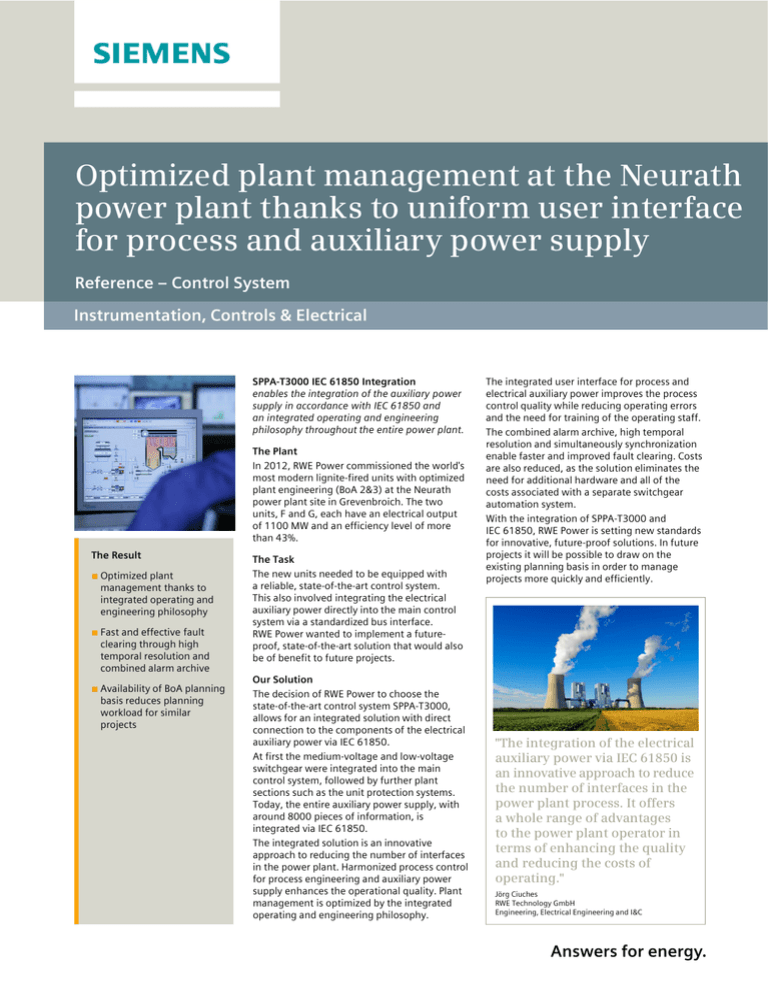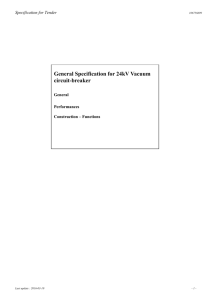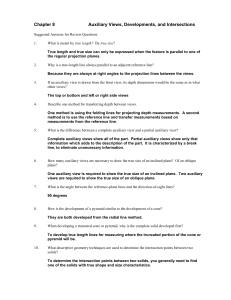
Optimized plant management at the Neurath
power plant thanks to uniform user interface
for process and auxiliary power supply
Reference – Control System
Instrumentation, Controls & Electrical
Width: 4,36
SPPA-T3000 IEC 61850 Integration
enables the integration of the auxiliary power
supply in accordance with IEC 61850 and
an integrated operating and engineering
philosophy throughout the entire power plant.
The Plant
In 2012, RWE Power commissioned the world's
most modern lignite-fired units with optimized
plant engineering (BoA 2&3) at the Neurath
power plant site in Grevenbroich. The two
units, F and G, each have an electrical output
of 1100 MW and an efficiency level of more
than 43%.
The Result
■ Optimized plant
management thanks to
integrated operating and
engineering philosophy
■ Fast and effective fault
clearing through high
temporal resolution and
combined alarm archive
■ Availability of BoA planning
basis reduces planning
workload for similar
projects
The Task
The new units needed to be equipped with
a reliable, state-of-the-art control system.
This also involved integrating the electrical
auxiliary power directly into the main control
system via a standardized bus interface.
RWE Power wanted to implement a futureproof, state-of-the-art solution that would also
be of benefit to future projects.
Our Solution
The decision of RWE Power to choose the
state-of-the-art control system SPPA-T3000,
allows for an integrated solution with direct
connection to the components of the electrical
auxiliary power via IEC 61850.
At first the medium-voltage and low-voltage
switchgear were integrated into the main
control system, followed by further plant
sections such as the unit protection systems.
Today, the entire auxiliary power supply, with
around 8000 pieces of information, is
integrated via IEC 61850.
The integrated solution is an innovative
approach to reducing the number of interfaces
in the power plant. Harmonized process control
for process engineering and auxiliary power
supply enhances the operational quality. Plant
management is optimized by the integrated
operating and engineering philosophy.
The integrated user interface for process and
electrical auxiliary power improves the process
control quality while reducing operating errors
and the need for training of the operating staff.
The combined alarm archive, high temporal
resolution and simultaneously synchronization
enable faster and improved fault clearing. Costs
are also reduced, as the solution eliminates the
need for additional hardware and all of the
costs associated with a separate switchgear
automation system.
With the integration of SPPA-T3000 and
IEC 61850, RWE Power is setting new standards
for innovative, future-proof solutions. In future
projects it will be possible to draw on the
existing planning basis in order to manage
projects more quickly and efficiently.
Width: 5,60
"The integration of the electrical
auxiliary power via IEC 61850 is
an innovative approach to reduce
the number of interfaces in the
power plant process. It offers
a whole range of advantages
to the power plant operator in
terms of enhancing the quality
and reducing the costs of
operating."
Jörg Ciuches
RWE Technology GmbH
Engineering, Electrical Engineering and I&C
Answers for energy.
Published by and copyright © 2013:
Siemens AG, Energy Sector
Freyeslebenstraße 1
91058 Erlangen, Germany
For more information contact
sppa-t3000.energy@siemens.com
www.siemens.com/energy/sppa-t3000
Siemens AG
Power Generation
Instrumentation, Controls & Electrical
Siemensallee 84
76187 Karlsruhe, Germany
T3_FR_Neurath-IEC61850_e_V1-0
Order no. E50001-G230-A367-X-4A00
Printed in Germany
Dispo 05401, c4bs-Nr. 7465
Printed on elementary chlorine-free
bleached paper.
Unrestricted
AL:N ECCN:N
All rights reserved.
Trademarks mentioned in this document are
the property of Siemens AG, its affiliates, or
their respective owners.
Subject to change without prior notice.
The information in this document contains
general descriptions of the technical options
available, which may not apply in all cases.
The required technical options should
therefore be specified in the contract.







